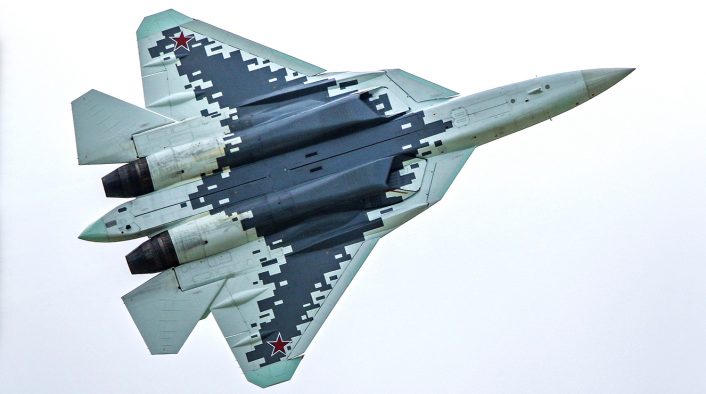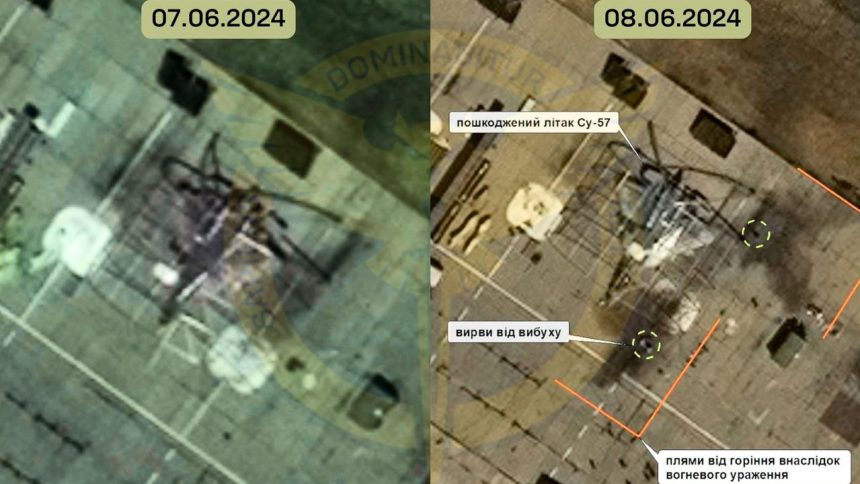In a first, a Russian 5th gen. fighter was hit at Akhtubinsk airfield in Astrakhan Oblast. The damage has been confirmed by Russian sources too.
Ukraine’s GUR, the Main Directorate of Intelligence of the Ministry of Defence of Ukraine, also known in English as the Defense Intelligence of Ukraine, announced to have hit a Su-57 Felon of the Russian Aerospace Forces.
The attack was carried out on June 8, 2024, and the Su-57 was hit while parked on the apron of Akhtubinsk airfield (home of the test-flight center of the Russian Aerospace Forces) in the Astrakhan region of the Russian Federation, located 589 kilometers from the front.
Satellite images were also release showing a comparison between the Su-57 on June 7 and June 8: the post-attack image shows what the Intelligence service says are small craters caused by the explosions and the characteristic scorch marks on the pavement caused by the heat and flames from the explosion.
‼️ Вперше уражено Су-57
💥 8 червня 2024 року на території аеродрому «ахтубінск» в астраханській області рф, розташованому за 589 кілометрів від лінії бойового зіткнення, уражено багатоцільовий винищувач держави-агресора Су-57.
🔗 https://t.co/vyatL7cBjd pic.twitter.com/8wbopryp4l
— Defence intelligence of Ukraine (@DI_Ukraine) June 9, 2024
“The pictures show that on June 7th, the Su-57 was standing intact, and on the eighth, there were ruptures from the explosion and characteristic spots of fire caused by fire damage near it,” says the GUR.
The attack marked the first time in history, a Su-57 was hit. Considering that just 20 Felon aircraft are believed to have been delivered, this would be a significant blow for the Russian Aerospace Forces.
Although the photos unequivocally demonstrate that there were explosions, it is difficult to determine the extent of any damage caused to the aircraft: the craters appear to be quite far away and it is not possible, due to the quality of the images, to assess whether the Russian 5th generation aircraft was been significantly damaged.
The successful attack and damage to the Su-57 was also acknowledged by the popular Russian FigherBomber Telegram Channel, with close ties with the Russian Aerospace Forces’ aircrews:
“Yes, yesterday the airfield in Akhtubinsk was attacked by a UAV. Three pieces arrived. The Su-57 was damaged by shrapnel; it is now being determined whether it can be restored or not. If not, then this will be the first loss of the Su-57 in history. I’ll tell you again. For the price of this Su-57 alone, shelters from UAVs could be built for all PTA aircraft in the country.”
Aircraft Protection
On February 26, 2023, Ukraine-affiliated Belarusian partisan group BYPOL, damaged an A-50U AWACS (Airborne Warning and Control System) by landing a kamikaze quadcopter on its radar disc at Machulishchy air base in Belarus.
Throughout the war we have observed different measures put in place by the Russians to protect their assets from the deadly Ukrainian strikes. In September 2023, Russia placed rubber “tires” on its bombers at Engels Air Base, home to the Tu-95 and Tu-160 strategic bombers, perhaps to provide added protection from drone and, possibly, Neptune missile strikes. This was because the Ukrainian Neptune, originally an anti-ship missile converted for land-strike roles, has a new thermal seeker that will not match the aircraft’s changed infrared signature, with the one loaded in its memory.
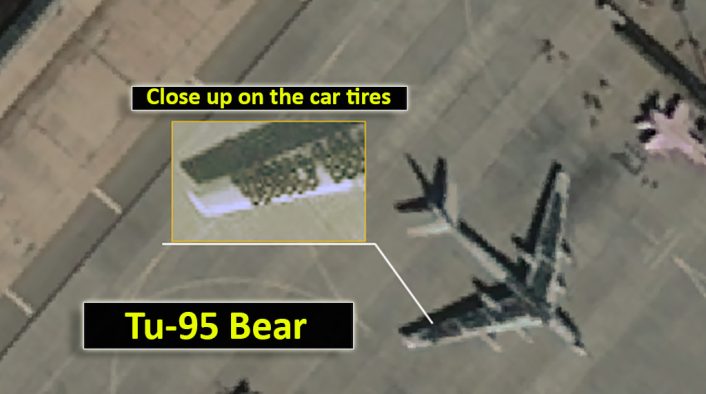
The car tires were placed on the wings and fuselage. At the time, experts said the tires could also be expected to bounce off attacking UAVs before they could hit the plane’s airframe. Even a single hit with a low-explosive warhead is enough to put an aircraft out of operation for a long time.
According to the Ukrainian sources, the the car tires were used as a sort of makeshift protection from attacks carried out with kamikaze drones a theory that we analysed here. However, since some of the bombers with the car tires on the wing had missing parts, it seemed also possible that the Tu-95s were decommissioned ones being used as decoys in case of kamikaze drones’ attacks.
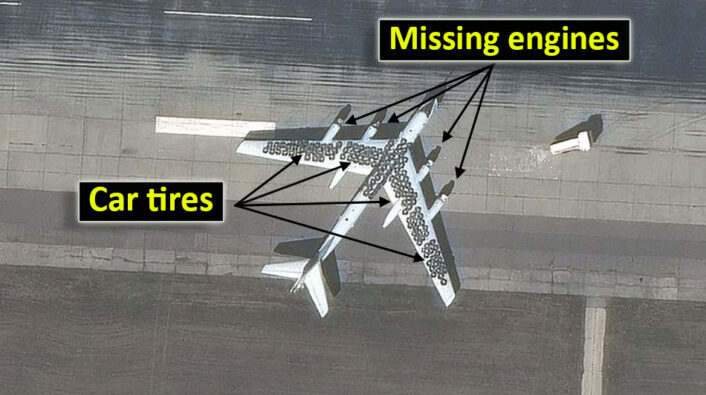
More or less in the same period, another photo was circulated online. Taken from the ground at an unknown airfield showed a Sukhoi Su-34 Fullback bomber with tires on the fuselage, wings and horizontal stabilizers.
On Sept. 10, 2023, the FighterBomber Telegram channel, posted some new images, showing what was described as an anti-drone structure being fielded for test purposes at an unspecified Russian airfield.
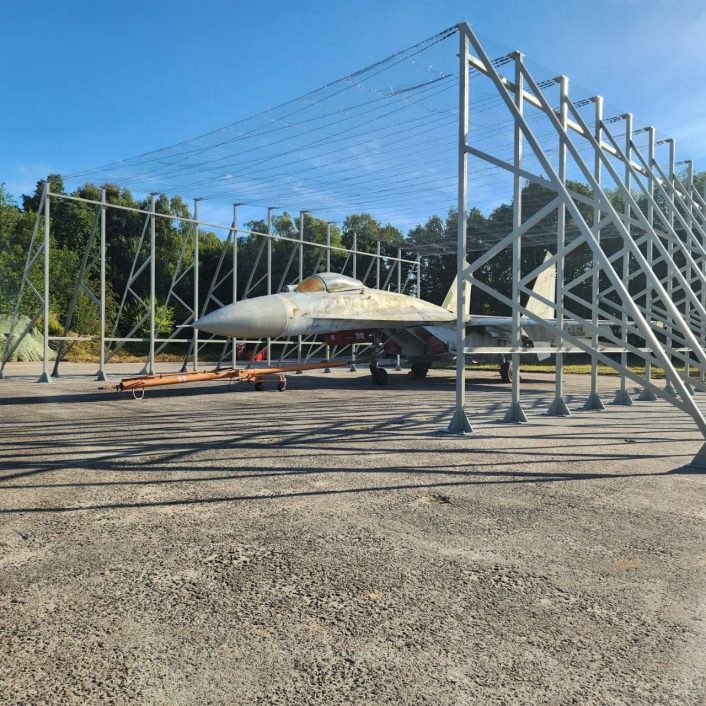
Those mentioned above were just two “creative” ways apparently put in place by Russia to mislead the deadly Ukrainian attack drones.
Besides inflatable tanks and wooden rocket launchers, in January 2024, an image captured by Planet Labs PBC and obtained by Business Insider showed the silhouette of a combat aircraft painted on the tarmac of Mozdok Air Base in southeast Russia. Similar decoys, painted some time between the summer and fall 2023, were exposed by satellite imagery of Belbek, Gvardeyskoye and Krymsk Air Base.
The reason for using such decoys was always the same: deceive the Ukrainian drones that rely on basic cameras for image recognition of aircraft shapes.
We recently reported about aircraft shelters at Russia’s Marinovka air base in Russia’s Volgograd region, 300-km from the border with Ukraine. After Ukraine’s strikes with ATACMS (Army Tactical Missile System) on Crimea’s Belbek air base on May 15, 2024, and the destruction of an S-400 AD (Air Defense) system at Mospyne on May 22-23.
The attack on Belbek destroyed MiG-31, MiG-29 and Su-27 fighters, as proved by satellite images from Maxar.
Anyway, as commented in the story about Marinovka air base, it’s still not clear how the aircraft can eventually be moved in and out of the shelter, considering the maneuvering space appears to be quite limited (the light shelters occupy more than half the width of the taxiway). For this reason, there are also chances the new shelters are just decoys.
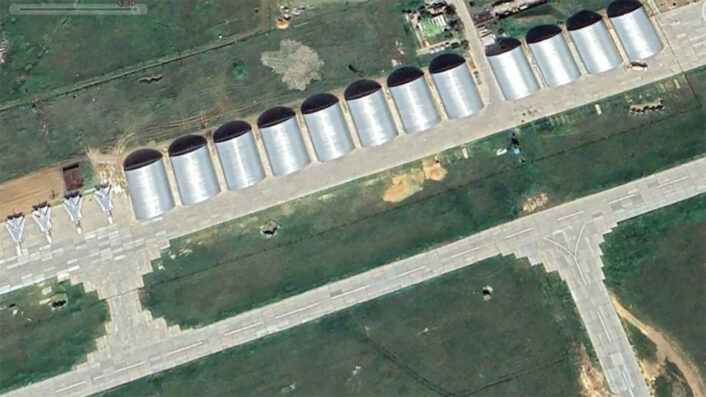
The Su-57 Felon
The Sukhoi Su-57 (NATO reporting name: Felon) is a low-observable, single-seat, twin-engine, multirole fifth-generation jet fighter developed since 2002. Sukhoi internally refers to the aircraft as T-50.
The Su-57 is intended to be the first stealth aircraft in Russian military service. The aircraft made its first flight on Jan. 29, 2010, with first serial production Felon delivered at the end of 2020.
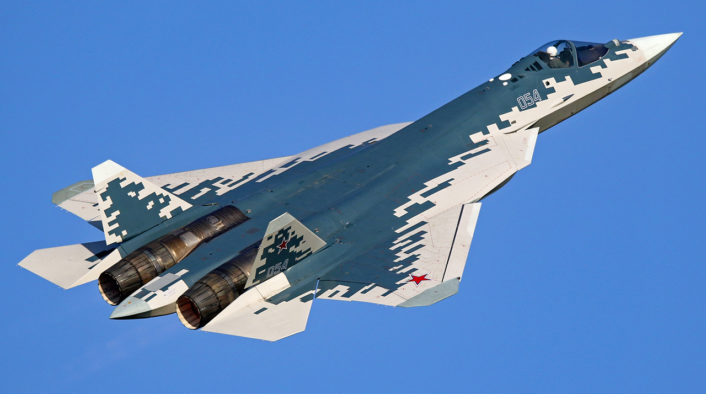
The Su-57’s design includes a blended wing body fuselage, all-moving horizontal and vertical stabilizers, with the vertical stabilizers doubling as airbrakes. It features thrust vectoring and adjustable leading-edge vortex controllers (LEVCONs) that manage vortices from the leading-edge root extensions, improve high angle of attack behavior, and allow quick stall recovery if needed. Its advanced flight control system and thrust vectoring nozzles make it highly maneuverable in both pitch and yaw, enabling maneuvers such as Pugachev’s Cobra and the bell maneuver, and performing flat rotations with minimal altitude loss.
The aircraft extensively uses composite materials, comprising 25% of its structural weight and nearly 70% of its outer surface. Weapons are stored in two tandem main bays between the engine nacelles and smaller side bays near the wing root, reducing drag and enhancing performance and stealth compared to external carriage.
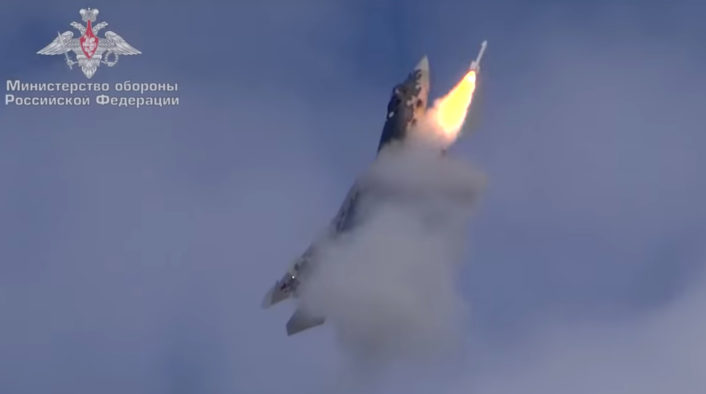
The Su-57’s aerodynamics and engines enable it to achieve Mach 2 and supercruise without afterburners, providing a significant performance advantage over previous generations. With a high fuel load, its supersonic range exceeds 1,500 km (930 mi), more than twice that of the Su-27, and an extendable refueling probe can further increase its range. According to a U.S. military assessment, in its design, Sukhoi addressed perceived limitations of the F-22, such as limited thrust vectoring for roll and yaw and insufficient space for weapons bays between the engines, and improved stall recovery procedures.
Initial prototypes and early production models used an upgraded variant of the Lyulka AL-31 engine, the AL-41F1A. A new engine was specifically developed for the Su-57, known as Izdeliye 30 (literally Product 30). The Product 30, which should provide 18,000 kgf of thrust instead of the 15,000 kgf of the AL-41F1A, is supposed to be more efficient than previous designs and able to give the Felon a top speed in excess of Mach 2 and a supercruise capability at Mach 1.3, featuring also 3D thrust vectoring and a “stealthier” nozzle. Production of the Product 30 engine began in 2022; the first serial deliveries of the Product 30-equipped Su-57 started in 2023.
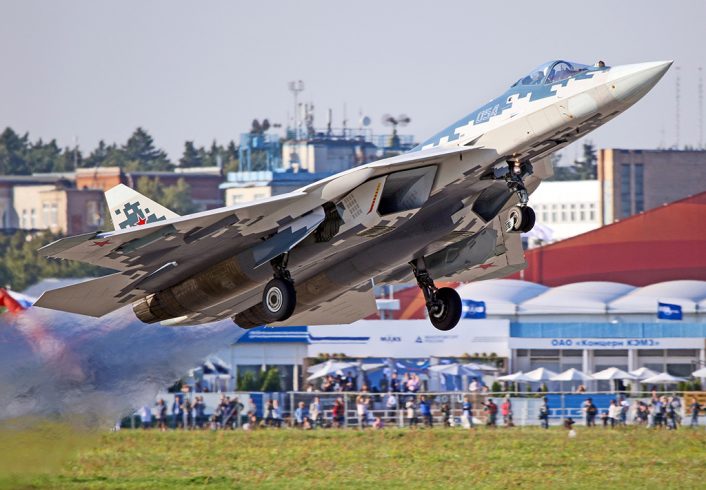
The Russian Air Force has ordered 76 aircraft. Initially, in August 2018, the Ministry of Defense of the Russian Federation and PJSC Sukhoi Company signed a contract for the first two serial Su-57s, T-50S-1 and T-50S-2.
A year later, a follow on contract for 74 other aircraft was inked bringing the total order to 76 Su-57s. The first delivery occurred at the end of 2020 when the first production-model Su-57 fighter, bort number Blue 01, was delivered to the 929th V.P. Chkalov State Flight Test Center in Akhtubinsk to be used to test hypersonic air-launched weapons.
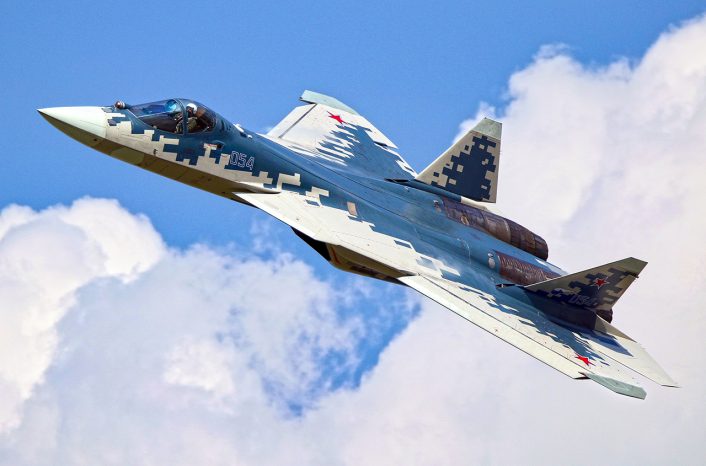
According to Russian Defense Minister Sergei Shoigu 22 Su-57s will be delivered by the end of 2024, while the deliveries (provided that no further aircraft will be added to the order) will be completed by 2028 at a rate of 16 aircraft per year.
This is what we wrote about the Su-57 in an article published last year, when the first series aircraft was delivered:
As you may know, Su-57 is the official designation of the T-50 stealth multirole 5th generation fighter jet that was developed under the PAK-FA program. The requirements envisioned an aircraft capable of supersonic cruise flight with a long combat radius, low radar cross section, super-maneuverability and STOL (Short Take Off and Landing) characteristics, while retaining a substantial ground attack capability. The Su-57 features a substantially reduced Radar Cross Section compared to 4th generation Russian jets, principally in the frontal sector. It seems to be a compromise between reducing the RCS and obtaining high maneuverability and performance while maintaining large weapons bays to accommodate heavy payloads.
The airframe is said to use composite materials up to the 25% of the total weight and Radar Absorbing Materials (RAM). Some of these composite materials had to be sourced from abroad, but now they have been reportedly replaced by “Made in Russia” materials. Another technology that was showcased on the production line is the use of Augmented Reality during a number of processes in the assembly of the Su-57, with some examples showing its usage on the fuselage and the landing gear.
The Sukhoi Su-57 was often criticized by experts for many features that could degrade the low observability such as rivets, weapon doors’, engine nacelles’ and air inlets’ rounded shaping, rough panel’s seamlines, etc. Some of those problems seem to be mitigated in later prototypes and more could have been solved before the serial production. Many of these seem to be missing, or at least reduced, on the aircraft that are now being built serially, as it was visible on T-50S-2 while it was under construction this summer during a visit of the Russian Defense Minister.
[…]
An interesting fact mentioned by the Izvestia newspaper is that the Su-57 may receive “invisibility covers” made of special polymers that are meant to protect the aircraft and its electronics from bad weather when parked in the open outside of hangars, while also making it difficult for foreign intelligence gathering systems to see the outlines of the aircraft in satellite imagery or to detect data about the aircraft’s electronic through SIGINT (SIGnals INTelligence).
In 2021, it was reported that the Russian MoD wanted to Su-57 squadrons with the Sukhoi S-70 Okhotnik or “Hunter-B” UCAV: testing was conducted to create a data link between the manned and unmanned aircraft, with the Su-57 pilots able to assign tasks to the UCAVs, with the S-70 playing the role of a “Loyal Wingman” for the Su-57 Felon.
One of the Su-57 prototypes was photographed wearing a special pixelated camouflage on the underside of the aircraft that mimics the plan view shape of the Hunter remotely piloted aircraft. Additionally, a silhouette of the Okhotnik drone, alongside a silhouette of the Felon has been painted on one of the vertical stabilizers of one of the jets. The silhouettes have a lightning strike between them, probably symbolizing the expected integration.
